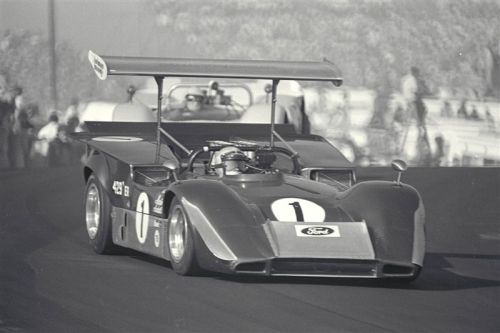FUMES
 Wednesday, November 3, 2010 at 09:02AM
Wednesday, November 3, 2010 at 09:02AM November 3, 2010
The Future is Now for Racing.
By Peter M. De Lorenzo
Detroit. I've written much over the years about the fact that racing needs a new idea and needs to press the re-set button in order to survive and thrive into the future. I've lobbied, I've personally cajoled the key players, I even gone so far as to engage the world's automobile manufacturers in bringing about a completely new take on racing - using electric fuel cell vehicles powered by hydrogen - to no avail. Well, I take that back. Scott Atherton was there when I introduced the Hydrogen Electric Racing Federation to a room full of curious manufacturers, motorsports industry professionals and media types that chilly day in January 2007, in Detroit, and he was the one man perceptive enough to know that it would be better to get out in front of these winds of change heading toward racing before that train left the station, and the future direction of the American Le Mans Series - the most technologically relevant form of racing on the planet today - was set into motion that very day.
But the fact of the matter is that here we are - now going on four years later - and not much has changed throughout the rest of the sport, which worries me. It worries me because I believe the sport is in considerable danger right now, that its very future is in jeopardy if the serious issues facing the sport are not addressed immediately.
It's not a popular perspective, I admit. As I've said before, it's easy for me and others to criticize the myriad directions that certain racing series take - such as IndyCar, NASCAR or Formula 1 - when we don't have a financial skin in the game. When IndyCar pulled up short with its new rules package I blasted its leaders to high heaven, saying it didn't go far enough. And I was blasted back behind the scenes and through my network of contacts, with the gist of the criticism leveled at me revolving around the fact that I didn't have $15 million tied up in an IndyCar team so what the hell would I know?
Point well taken, however narrowly-focused and misguided it may have been, but understood perfectly. Ultimately, however, that wasn't the point of my raising the red flag at all. The point was that even though given all of the factors - cost to the teams, attracting interested manufacturers, fan interest, etc. - IndyCar chose a path of transition instead of a radical transformation that would not only make the Indianapolis 500 the most relevant single race in the world - on top of already being the most prestigious - but it would also trigger a global transformation for the sport of racing itself. In other words when IndyCar made its fateful decision to pull up and go all conservative, it was quite clear then and there that The Future of Racing won't be beginning in 2012 at the Indianapolis Motor Speedway. Instead, another technological holding pattern will be introduced to the sport exactly at the time when it will least be able to afford it.
As I make my rounds through the halls of power among the manufacturers it has been made crystal clear to me - and repeatedly so I might add - that the sport needs a new idea. That in order for these manufacturers to get juiced about racing and open-wheel racing in particular - which is declining in interest for these car companies by the day - the racing series in question must provide a forum for not only technical relevance, but for technical innovation. These manufacturers spend billions upon billions of dollars on advanced technological research and development, and they're crying for a forum to test and prove their new stuff, which is why the 24 Hours of Le Mans and the American Le Mans Series are growing in stature by the minute.
As for IndyCar and the Indianapolis 500? The clock is ticking. And here are my key recommendations on how to fix it and point it to a relevant and energized - and energy efficient - future.
Rule No. 1: 50 gallons of fuel will be given to each team to run the 500 miles at Indy beginning in 2012 - different fuel densities and power will be adjusted for and equalized - and this formula will be used through the 2014 race. Beginning in 2015, the amount of fuel and equivalent alterantives for the 500 miles will be reduced to 40 gallons, in 2017, 30 gallons, and by 2020, 25 gallons of fuel will be allotted for the 500 miles. Then, given the technological development of power sources, alternative limits will be studied and introduced.
Rule No. 2: Given the fuel consumption requirements above, powertrains will then be free. That means conventional and unconventional internal combustion engines, hybrids, diesels, electrification, fuel cells and anything that hasn't been thought of yet will be eligible.
Rule No. 3: All racing machines must fit in a dimensional envelope or "box" established by IndyCar in order to compete, otherwise - and being mindful of all advanced safety requirements - design, construction, configuration and aerodynamics will be free.
Rule No. 4: Conventional wheels and tires will be eliminated beginning with the 2015 season, replaced by the Michelin Tweel and other similar competitors. Google "Michelin Tweel" to get an idea of what I mean.
That's it. Four innovative, transformational and deceptively simple rules that would radically transform IndyCar and motorsport globally. The idea is to stimulate new thinking and creativity while delivering high-performance with high-efficiency. If a manufacturer has a radical new idea, what is the fastest way to prove its worth? By racing it. There is no time for status meetings, hand-wringing, running it up the flag pole to see which way the political winds are blowing or second-guessing. When you have to be ready to roll out on that starting grid for qualifying or for a race, you need solutions and ideas right now.
And I contend that far from bankrupting the teams currently involved in the sport, manufacturers will be stimulated to participate and partner-up with teams to win the Indianapolis 500 in a new "golden era" for motorsport, where technological innovation and achievement will power the sport to new heights.
This is a different planet now, and the societal winds of change that are accelerating at a frenzied pace are translating into stiff headwinds for the sport as we know it. In the past when racing was on an upward trajectory it was hard - if not damn-near impossible - for enthusiasts to envision a day when interest in the sport could wane, or when factions outside the sport would conspire to dismiss motor racing as being wasteful, irresponsible and unnecessary, given the global environmental concerns and stresses on the planet's resources, etc., etc.
But the fact of the matter is that we are there right now. We are on the precipice of a downward spiral for the sport that could ultimately prove to be fatal if it's not addressed with the utmost of urgency. I for one love historic racing, but I don't want the entire sport sentenced to those confines going forward. And believe me, if we're not careful, that could very well happen.
There are plenty of smart people at the automobile companies, at their suppliers and throughout motorsport today with the knowledge, expertise and the talent to make a profound difference in the outcome of this opportunity.
And the time is now for these people to step up, get motivated, and redefine, re-energize and flat-out save this sport before it's too late.
Publisher's Note: As part of our continuing series celebrating the "Glory Days" of racing, we're proud to present another noteworthy image from the Ford Racing Archives. - PMD
 (Courtesy of the Ford Racing Archives)
(Courtesy of the Ford Racing Archives)
Riverside, California, October 26, 1969. Mario Andretti wheels his No. 1 Holman & Moody McLaren M6B powered by a 429 cubic inch Ford at the Los Angles Times Grand Prix Can-Am race. Andretti qualified sixth and finished third, 1-lap behind winner and pole-sitter Denny Hulme (No. 5 McLaren Cars Ltd. Gulf/Reynolds Aluminum McLaren M8B Chevrolet), and on the same lap as 2nd-place finisher Chuck Parsons (No. 10 Carl A. Hass Racing Team Simoniz Lola T163B Chevrolet). Other notable competitors that day were Dan Gurney (No. 48 All American Racers Olsonite McLaren M6B Chevrolet) who finished 4th, and Peter Revson (No. 31 Robbins-Jefferies Racing LolaT163 Chevrolet) who finished 5th, both on the same lap as Parsons and Andretti.
Publisher's Note: Like these Ford racing photos? Check out ford.artehouse.com. Be forewarned, however, because you won't be able to go there and not order something. - PMD
See another live episode of "Autoline After Hours" with hosts John McElroy, from Autoline Detroit, and Peter De Lorenzo, The Autoextremist, and guests this Thursday evening, at 7:00PM EDT at www.autolinedetroit.tv.
By the way, if you'd like to subscribe to the Autoline After Hours podcasts, click on the following links:
Subscribe via iTunes:
http://itunes.apple.com/WebObjects/MZStore.woa/wa/viewPodcast?id=311421319
Subscribe via RSS:
http://www.autolinedetroit.tv/podcasts/feeds/afterhours-audio.xml





